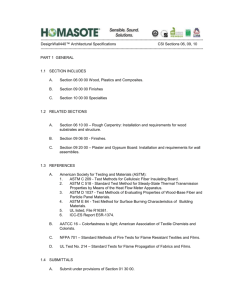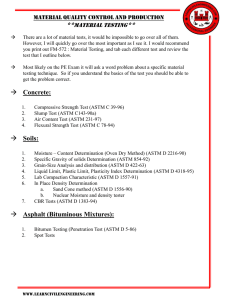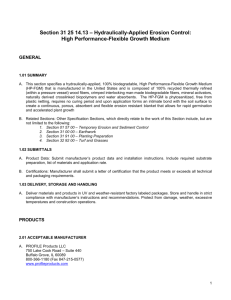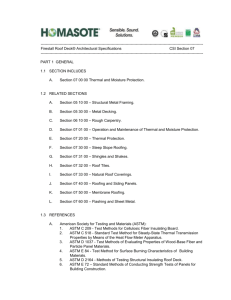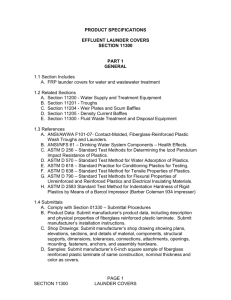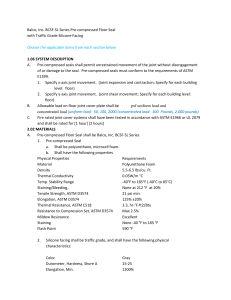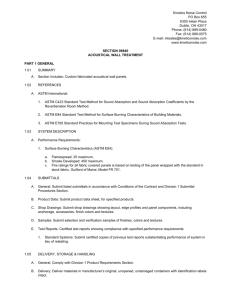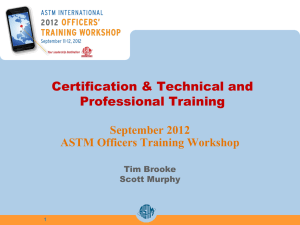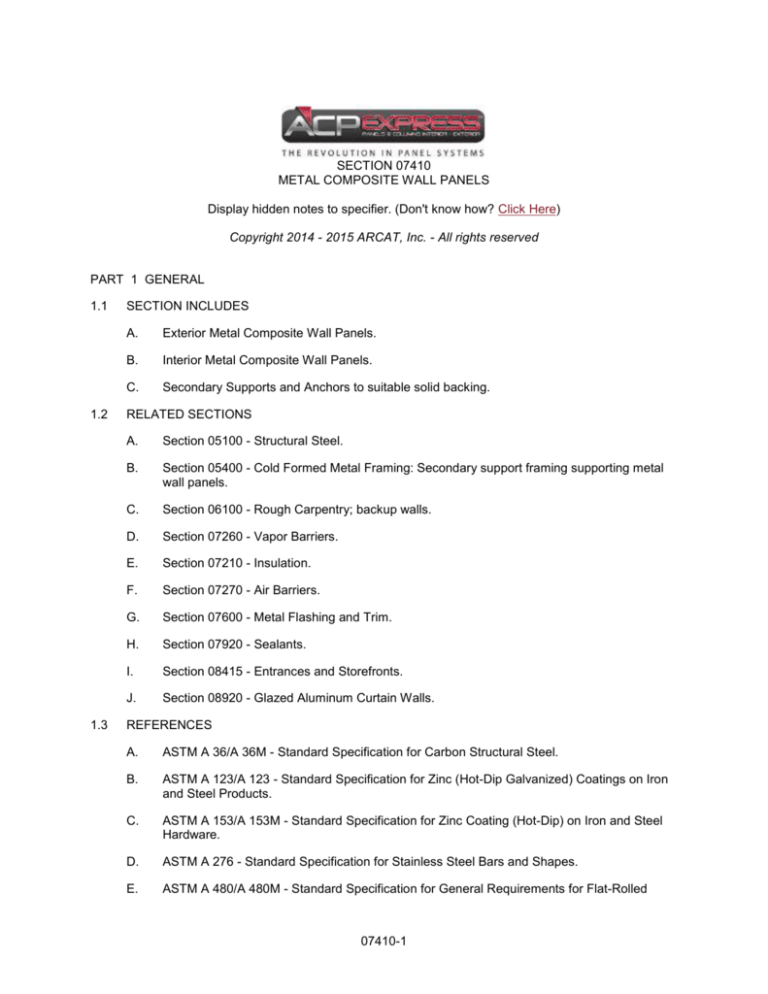
SECTION 07410
METAL COMPOSITE WALL PANELS
Display hidden notes to specifier. (Don't know how? Click Here)
Copyright 2014 - 2015 ARCAT, Inc. - All rights reserved
PART 1 GENERAL
1.1
1.2
1.3
SECTION INCLUDES
A.
Exterior Metal Composite Wall Panels.
B.
Interior Metal Composite Wall Panels.
C.
Secondary Supports and Anchors to suitable solid backing.
RELATED SECTIONS
A.
Section 05100 - Structural Steel.
B.
Section 05400 - Cold Formed Metal Framing: Secondary support framing supporting metal
wall panels.
C.
Section 06100 - Rough Carpentry; backup walls.
D.
Section 07260 - Vapor Barriers.
E.
Section 07210 - Insulation.
F.
Section 07270 - Air Barriers.
G.
Section 07600 - Metal Flashing and Trim.
H.
Section 07920 - Sealants.
I.
Section 08415 - Entrances and Storefronts.
J.
Section 08920 - Glazed Aluminum Curtain Walls.
REFERENCES
A.
ASTM A 36/A 36M - Standard Specification for Carbon Structural Steel.
B.
ASTM A 123/A 123 - Standard Specification for Zinc (Hot-Dip Galvanized) Coatings on Iron
and Steel Products.
C.
ASTM A 153/A 153M - Standard Specification for Zinc Coating (Hot-Dip) on Iron and Steel
Hardware.
D.
ASTM A 276 - Standard Specification for Stainless Steel Bars and Shapes.
E.
ASTM A 480/A 480M - Standard Specification for General Requirements for Flat-Rolled
07410-1
Stainless and Heat-Resisting Steel Plate, Sheet, and Strip.
1.4
F.
ASTM A 653/A 653M - Standard Specification for Steel Sheet, Zinc-Coated (Galvanized) or
Zinc-Iron Alloy-Coated (Galvannealed) by the Hot-Dip Process.
G.
ASTM A 666 - Standard Specification for Annealed or Cold-Worked Austenitic Stainless
Steel Sheet, Strip, Plate, and Flat Bar.
H.
ASTM A 792/A 792M - Standard Specification for Steel Sheet, 55 % Aluminum-Zinc AlloyCoated by the Hot-Dip Process.
I.
ASTM D 1781 - Standard Test Method for Climbing Drum Peel for Adhesives
J.
ASTM D 1929 - Standard Test Method for Determining Ignition Temperature of Plastics.
K.
ASTM E 84 - Standard Test Method for Surface Burning Characteristics of Building
Materials.
L.
ASTM E 283 - Standard Test Method for Rate of Air Leakage through Exterior Windows,
Curtain Walls, and Doors.
M.
ASTM E 330 - Standard Test Method for Structural Performance of Exterior Windows,
Curtain Walls, and Doors under the Influence of Wind Loads.
N.
ASTM E 331 - Standard Test Method for Water Penetration of Exterior Windows, Curtain
Walls, and Doors by Uniform Static Air Pressure Difference.
SUBMITTALS
A.
Submit under provisions of Section 01300.
B.
Product Data: Manufacturer's data sheets on each product to be used, including:
1.
Data sheets showing systems physical and performance characteristics.
2.
Storage and handling requirements and recommendations.
3.
Installation instructions and requirements.
C.
Shop Drawings: Show layout and elevations, dimensions and thickness of panels,
connections, details and location of joints, sealants and gaskets, method of anchorage,
number of anchors, supports, reinforcement, trim, flashings, and accessories.
1.
Indicate panel numbering system.
2.
Differentiate between shop and field fabrication.
3.
Indicate substrates and adjacent work with which the wall system must be
coordinated.
4.
Include large-scale details of anchorages and connecting elements.
5.
Include large-scale details or schematic, exploded or isometric diagrams to fully
explain flashing at a scale of not less than 1-1/2 inches per 12 inches.
D.
Design Data:
1.
Submit manufacturer's structural calculations showing sizes of framing members and
loads applied to supporting structure based on design loads.
2.
Structural calculations shall be prepared by a professional engineer qualified in design
of cladding system and licensed in state where system is to be installed.
E.
Test Report: Submit report of full-size mock-up tests for air infiltration, water penetration, and
wind performance.
F.
Manufacturer's Field Reports: Submit reports within 48 hours of field review. State what was
observed and what changes, if any, were requested or required.
07410-2
1.5
1.6
1.7
1.8
G.
Selection Samples: For each finish product specified, two complete sets of color chips
representing manufacturer's full range of available colors and patterns.
H.
Verification Samples: For each finish product specified, two samples, minimum size 6 inches
(150 mm) square, representing actual product, color, and patterns.
I.
Manufacturer's Certificates: Certify products meet or exceed specified requirements.
J.
Closeout Submittals: Provide manufacturer's maintenance instructions for care of finishes
and warranty requirements. Submit executed warranty in Owner's name and registered with
manufacturer.
QUALITY ASSURANCE
A.
Manufacturer Qualifications: Company specializing in manufacturing products specified in
this section with not less than three years of documented experience.
B.
Installer Qualifications: Company specializing in installing products specified in this section
with not less than three years of documented experience.
C.
Design Engineer's Qualifications: Design structural supports and anchorages under direct
supervision of a Structural Engineer experienced in design of this type of Work and licensed
in the project location.
D.
Field Measurements: Verify actual dimensions by field measurement before fabrication;
show recorded measurements on shop drawings.
DELIVERY, STORAGE, AND HANDLING
A.
Deliver products in manufacturer's original, unopened, undamaged containers with
identification labels intact.
1.
Protect finishes by applying heavy duty removable plastic film during production.
2.
Package for protection against transportation damage.
3.
Provide markings to identify components consistently with Drawings.
4.
Exercise care in unloading, storing and installing panels to prevent bending, warping,
twisting and surface damage.
B.
Store products protected from exposure to harmful weather conditions and at temperature
conditions recommended by manufacturer.
1.
Store in well ventilated space out of direct sunlight.
2.
Protect from moisture and condensation with tarpaulins or other suitable weather tight
covering installed to provide ventilation.
3.
Store at a slope to ensure positive drainage of any accumulated water.
4.
Do not store in any enclosed space where ambient temperature can exceed 120
degrees F.
5.
Avoid contact with any other materials that might cause staining, denting, or other
surface damage.
SEQUENCING
A.
Ensure that locating templates and other information required for installation of products of
this section are furnished to affected trades in time to prevent interruption of construction
progress.
B.
Ensure that products of this section are supplied to affected trades in time to prevent
interruption of construction progress.
PROJECT CONDITIONS
07410-3
A.
1.9
Maintain environmental conditions (temperature, humidity, and ventilation) during installation
within limits recommended by manufacturer for optimum results. Do not install products
under environmental conditions outside manufacturer's absolute limits.
WARRANTY
A.
Wall System Warranty: Provide joint written warranty by manufacturer and installer, agreeing
to correct defects in manufacturing or installation within a two year period after Date of
Substantial Completion.
B.
Paint Warranty: Provide 30-year Kynar paint finish warranty.
PART 2 PRODUCTS
2.1
2.2
MANUFACTURERS
A.
Acceptable Manufacturer, Wall Panel System; ACPEXPRESS, 1036 Anderson Ave., Fort
Lee, NJ 07024. ASD. Toll Free: 844-227-3977. Phone: 201-873-3600. Fax: 201-863-7401.
Email:info@acpexpress.com. www.ACPEXPRESS.com.
B.
Acceptable Manufacturer, Metal Composite Material:
1.
ALPOLIC - Mitsubishi Plastics Composites America, Inc.; 401 Volco Parkway,
Chesapeake, VA 23320;Tel:757)382-5721; Fax: (757)436-1896;info@alpolic.com;
Website:www.alpolic-usa.com
2.
ALUCOBOND - 3A Composites USA; 23160 Network Place, Chicago, IL 60673; Toll
Free: (866)275-1935; Fax: (270)527-4270; Email:laura.wilson@3acomposites.com;
Website:www.3acomposites.com
3.
REYNOBOND - Alcoa Architectural Products; 23 Seneca Road, Crandford, NJ 07016;
Tel: (908)276-5690; Fax: (908)276-5854; Email:mmuntz@celtic-4.com; Website:
www.alcoa.co
C.
Substitutions: Not permitted.
D.
Requests for substitutions will be considered in accordance with provisions of Section 01 25
00.
WALL PANEL SYSTEM
A.
Wall Panel System:
1.
ACPEXPRESS H-100 Exterior: Installed as a straight run with notches to
accommodate horizontal extrusion joints that permits water to run down the wall
without any snag points preventing water ingress.
a.
Performance Requirements: Panel system shall have the following minimum
performance capabilities:
1)
Thermal Movement: Provide for free and noiseless vertical and
horizontal thermal movement due to expansion and contraction under
material temperature range of minus 20 degrees F to 180 degrees F
without buckling, opening of joints, undue stress on fasteners, or other
detrimental effects; allow for ambient temperature at time of fabrication,
assembly, and erection procedures.
2)
Wind Performance: Provide system tested in accordance with ASTM E
330 without permanent deformation or failures of structural members.
a)
To withstand a Uniform Structural Load of plus 100.25 psf / minus
90.23 held for 10 seconds.
b)
Maximum deflection of perimeter framing member of L/175 normal
to plane of the wall; maximum deflection of individual panels of
L/60.
07410-4
c)
2.
3.
Maximum anchor deflection in any direction of 1/16 inch at
connection points of framing members to anchors.
3)
Air Infiltration: 0.02 cfm/sq ft of wall area, maximum, when tested at 6.2
psf in accordance with ASTM E 283.
4)
Water Penetration: No water penetration under static pressure when
tested in accordance with ASTM E 331 at a differential of 10 percent of
inward acting design load, 15.04 psf minimum, after 15 minutes.
a)
Water penetration is defined as the appearance of uncontrolled
water on the interior face of the wall.
b)
Design to drain leakage and condensation to the exterior face of
the wall.
ACPEXPRESS H-100-3D: Installed as a straight run with notches to accommodate
horizontal extrusion joints that permits water to run down the wall without any snag
points preventing water ingress.
a.
Performance Requirements: Panel system shall have the following minimum
performance capabilities:
1)
Thermal Movement: Provide for free and noiseless vertical and
horizontal thermal movement due to expansion and contraction under
material temperature range of minus 20 degrees F to 180 degrees F
without buckling, opening of joints, undue stress on fasteners, or other
detrimental effects; allow for ambient temperature at time of fabrication,
assembly, and erection procedures.
2)
Wind Performance: Provide system tested in accordance with ASTM E
330 without permanent deformation or failures of structural members.
a)
To withstand a Uniform Structural Load of plus 100.25 psf / minus
90.23 held for 10 seconds.
b)
Maximum deflection of perimeter framing member of L/175 normal
to plane of the wall; maximum deflection of individual panels of
L/60.
c)
Maximum anchor deflection in any direction of 1/16 inch at
connection points of framing members to anchors.
3)
Air Infiltration: 0.02 cfm/sq ft of wall area, maximum, when tested at 6.2
psf in accordance with ASTM E 283.
4)
Water Penetration: No water penetration under static pressure when
tested in accordance with ASTM E 331 at a differential of 10 percent of
inward acting design load, 15.04 psf minimum, after 15 minutes.
a)
Water penetration is defined as the appearance of uncontrolled
water on the interior face of the wall.
b)
Design to drain leakage and condensation to the exterior face of
the wall.
ACPEXPRESS H-100-3D-C Exterior Concave 3D: Installed as a straight run with
notches to accommodate horizontal extrusion joints that permits water to run down the
wall without any snag points preventing water ingress.
a.
Performance Requirements: Panel system shall have the following minimum
performance capabilities:
1)
Thermal Movement: Provide for free and noiseless vertical and
horizontal thermal movement due to expansion and contraction under
material temperature range of minus 20 degrees F to 180 degrees F
without buckling, opening of joints, undue stress on fasteners, or other
detrimental effects; allow for ambient temperature at time of fabrication,
assembly, and erection procedures.
2)
Wind Performance: Provide system tested in accordance with ASTM E
330 without permanent deformation or failures of structural members.
a)
To withstand a Uniform Structural Load of plus 100.25 psf / minus
90.23 held for 10 seconds.
b)
Maximum deflection of perimeter framing member of L/175 normal
07410-5
4.
5.
to plane of the wall; maximum deflection of individual panels of
L/60.
c)
Maximum anchor deflection in any direction of 1/16 inch at
connection points of framing members to anchors.
3)
Air Infiltration: 0.02 cfm/sq ft of wall area, maximum, when tested at 6.2
psf in accordance with ASTM E 283.
4)
Water Penetration: No water penetration under static pressure when
tested in accordance with ASTM E 331 at a differential of 10 percent of
inward acting design load, 15.04 psf minimum, after 15 minutes.
a)
Water penetration is defined as the appearance of uncontrolled
water on the interior face of the wall.
b)
Design to drain leakage and condensation to the exterior face of
the wall.
ACPEXPRESS H-100A Exterior: Designed and ASTM structurally tested for use in
Exterior applications.
a.
Performance Requirements: Panel system shall have the following minimum
performance capabilities:
1)
Thermal Movement: Provide for free and noiseless vertical and
horizontal thermal movement due to expansion and contraction under
material temperature range of minus 20 degrees F to 180 degrees F
without buckling, opening of joints, undue stress on fasteners, or other
detrimental effects; allow for ambient temperature at time of fabrication,
assembly, and erection procedures.
2)
Wind Performance: Provide system tested in accordance with ASTM E
330 without permanent deformation or failures of structural members.
a)
To withstand a Uniform Structural Load of plus 105 psf / minus 90
held for 10 seconds.
b)
Maximum deflection of perimeter framing member of L/175 normal
to plane of the wall; maximum deflection of individual panels of
L/60.
c)
Maximum anchor deflection in any direction of 1/16 inch at
connection points of framing members to anchors.
3)
Air Infiltration: 0.11 cfm/sq ft of wall area, maximum, when tested at 12.0
psf in accordance with ASTM E 283.
4)
Water Penetration: No water penetration under static pressure when
tested in accordance with ASTM E 331 at a differential of 10 percent of
inward acting design load, 15.04 psf minimum, after 15 minutes.
a)
Water penetration is defined as the appearance of uncontrolled
water on the interior face of the wall.
b)
Design to drain leakage and condensation to the exterior face of
the wall.
ACPEXPRESS H-100A-3D Exterior Aluminum Attachment System: Designed and
ASTM structurally tested for use in Exterior applications with H-100, H-100-3D, and H200 panel systems.
a.
Performance Requirements: Panel system shall have the following minimum
performance capabilities:
1)
Thermal Movement: Provide for free and noiseless vertical and
horizontal thermal movement due to expansion and contraction under
material temperature range of minus 20 degrees F to 180 degrees F
without buckling, opening of joints, undue stress on fasteners, or other
detrimental effects; allow for ambient temperature at time of fabrication,
assembly, and erection procedures.
2)
Wind Performance: Provide system tested in accordance with ASTM E
330 without permanent deformation or failures of structural members.
a)
To withstand a Uniform Structural Load of plus 105 psf / minus 90
held for 10 seconds.
07410-6
b)
6.
7.
Maximum deflection of perimeter framing member of L/175 normal
to plane of the wall; maximum deflection of individual panels of
L/60.
c)
Maximum anchor deflection in any direction of 1/16 inch at
connection points of framing members to anchors.
3)
Air Infiltration: 0.11 cfm/sq ft of wall area, maximum, when tested at 12.0
psf in accordance with ASTM E 283.
4)
Water Penetration: No water penetration under static pressure when
tested in accordance with ASTM E 331 at a differential of 10 percent of
inward acting design load, 15.04 psf minimum, after 15 minutes.
a)
Water penetration is defined as the appearance of uncontrolled
water on the interior face of the wall.
b)
Design to drain leakage and condensation to the exterior face of
the wall.
ACPEXPRESS H-100A-3D-C Exterior: Designed and ASTM structurally tested for use
in Exterior applications.
a.
Performance Requirements: Panel system shall have the following minimum
performance capabilities:
1)
Thermal Movement: Provide for free and noiseless vertical and
horizontal thermal movement due to expansion and contraction under
material temperature range of minus 20 degrees F to 180 degrees F
without buckling, opening of joints, undue stress on fasteners, or other
detrimental effects; allow for ambient temperature at time of fabrication,
assembly, and erection procedures.
2)
Wind Performance: Provide system tested in accordance with ASTM E
330 without permanent deformation or failures of structural members.
a)
To withstand a Uniform Structural Load of plus 105 psf / minus 90
held for 10 seconds.
b)
Maximum deflection of perimeter framing member of L/175 normal
to plane of the wall; maximum deflection of individual panels of
L/60.
c)
Maximum anchor deflection in any direction of 1/16 inch at
connection points of framing members to anchors.
3)
Air Infiltration: 0.11 cfm/sq ft of wall area, maximum, when tested at 12.0
psf in accordance with ASTM E 283.
4)
Water Penetration: No water penetration under static pressure when
tested in accordance with ASTM E 331 at a differential of 10 percent of
inward acting design load, 15.0 psf minimum, after 15 minutes.
a)
Water penetration is defined as the appearance of uncontrolled
water on the interior face of the wall.
b)
Design to drain leakage and condensation to the exterior face of
the wall.
ACPEXPRESS H-200 Interior: Installed as a straight run with notches to speed up the
installation.
a.
Performance Requirements: Panel system shall have the following minimum
performance capabilities:
1)
Thermal Movement: Provide for free and noiseless vertical and
horizontal thermal movement due to expansion and contraction under
material temperature range of minus 20 degrees F to 180 degrees F
without buckling, opening of joints, undue stress on fasteners, or other
detrimental effects; allow for ambient temperature at time of fabrication,
assembly, and erection procedures.
2)
Wind Performance: Provide system tested in accordance with ASTM E
330 without permanent deformation or failures of structural members.
a)
To withstand a Uniform Structural Load of plus 100.25 psf / minus
90.23 held for 10 seconds.
07410-7
b)
8.
9.
10.
Maximum deflection of perimeter framing member of L/175 normal
to plane of the wall; maximum deflection of individual panels of
L/60.
c)
Maximum anchor deflection in any direction of 1/16 inch at
connection points of framing members to anchors.
3)
Air Infiltration: NA interior application.
4)
Water Penetration: NA interior application.
ACPEXPRESS H-200-R Interior Removable: Installed as a straight run with notches
to speed up the installation.
a.
Performance Requirements: Panel system shall have the following minimum
performance capabilities:
1)
Thermal Movement: Provide for free and noiseless vertical and
horizontal thermal movement due to expansion and contraction under
material temperature range of minus 20 degrees F to 180 degrees F
without buckling, opening of joints, undue stress on fasteners, or other
detrimental effects; allow for ambient temperature at time of fabrication,
assembly, and erection procedures.
2)
Wind Performance: Provide system tested in accordance with ASTM E
330 without permanent deformation or failures of structural members.
a)
To withstand a Uniform Structural Load of plus minus 26.6 psf and
Overload Pressure of minus 40.0 psf.
b)
Maximum deflection of perimeter framing member of L/175 normal
to plane of the wall; maximum deflection of individual panels of
L/60.
c)
Maximum anchor deflection in any direction of 1/16 inch at
connection points of framing members to anchors.
3)
Air Infiltration: NA interior application.
4)
Water Penetration: NA interior application.
ACPEXPRESS H-200-3D Interior Convex 3D: Installed as a straight run with notches
to speed up the installation.
a.
Performance Requirements: Panel system shall have the following minimum
performance capabilities:
1)
Thermal Movement: Provide for free and noiseless vertical and
horizontal thermal movement due to expansion and contraction under
material temperature range of minus 20 degrees F to 180 degrees F
without buckling, opening of joints, undue stress on fasteners, or other
detrimental effects; allow for ambient temperature at time of fabrication,
assembly, and erection procedures.
2)
Wind Performance: Provide system tested in accordance with ASTM E
330 without permanent deformation or failures of structural members.
a)
To withstand a Uniform Structural Load of plus 100.25 psf / minus
90.23 held for 10 seconds.
b)
Maximum deflection of perimeter framing member of L/175 normal
to plane of the wall; maximum deflection of individual panels of
L/60.
c)
Maximum anchor deflection in any direction of 1/16 inch at
connection points of framing members to anchors.
3)
Air Infiltration: NA interior application.
4)
Water Penetration: NA interior application.
ACPEXPRESS H-200-3D-R Interior Removable Convex 3D: Installed as a straight run
with notches to speed up the installation.
a.
Performance Requirements: Panel system shall have the following minimum
performance capabilities:
1)
Thermal Movement: Provide for free and noiseless vertical and
horizontal thermal movement due to expansion and contraction under
material temperature range of minus 20 degrees F to 180 degrees F
07410-8
11.
12.
without buckling, opening of joints, undue stress on fasteners, or other
detrimental effects; allow for ambient temperature at time of fabrication,
assembly, and erection procedures.
2)
Wind Performance: Provide system tested in accordance with ASTM E
330 without permanent deformation or failures of structural members.
a)
To withstand a Uniform Structural Load of plus minus 26.6 psf and
Overload Pressure of minus 40.0 psf.
b)
Maximum deflection of perimeter framing member of L/175 normal
to plane of the wall; maximum deflection of individual panels of
L/60.
c)
Maximum anchor deflection in any direction of 1/16 inch at
connection points of framing members to anchors.
3)
Air Infiltration: NA interior application.
4)
Water Penetration: NA interior application.
ACPEXPRESS H-200-3D-C Interior Concave 3D: Installed as a straight run with
notches to speed up the installation.
a.
Performance Requirements: Panel system shall have the following minimum
performance capabilities:
1)
Thermal Movement: Provide for free and noiseless vertical and
horizontal thermal movement due to expansion and contraction under
material temperature range of minus 20 degrees F to 180 degrees F
without buckling, opening of joints, undue stress on fasteners, or other
detrimental effects; allow for ambient temperature at time of fabrication,
assembly, and erection procedures.
2)
Wind Performance: Provide system tested in accordance with ASTM E
330 without permanent deformation or failures of structural members.
a)
To withstand a Uniform Structural Load of plus 100.25 psf / minus
90.23 held for 10 seconds.
b)
Maximum deflection of perimeter framing member of L/175 normal
to plane of the wall; maximum deflection of individual panels of
L/60.
c)
Maximum anchor deflection in any direction of 1/16 inch at
connection points of framing members to anchors.
3)
Air Infiltration: NA interior application.
4)
Water Penetration: NA interior application.
ACPEXPRESS H-200-3D-C-R Interior Removable Concave 3D: Installed as a straight
run with notches to speed up the installation.
a.
Performance Requirements: Panel system shall have the following minimum
performance capabilities:
1)
Thermal Movement: Provide for free and noiseless vertical and
horizontal thermal movement due to expansion and contraction under
material temperature range of minus 20 degrees F to 180 degrees F
without buckling, opening of joints, undue stress on fasteners, or other
detrimental effects; allow for ambient temperature at time of fabrication,
assembly, and erection procedures.
2)
Wind Performance: Provide system tested in accordance with ASTM E
330 without permanent deformation or failures of structural members.
a)
To withstand a Uniform Structural Load of plus minus 26.6 psf and
Overload Pressure of minus 40.0 psf.
b)
Maximum deflection of perimeter framing member of L/175 normal
to plane of the wall; maximum deflection of individual panels of
L/60.
c)
Maximum anchor deflection in any direction of 1/16 inch at
connection points of framing members to anchors.
3)
Air Infiltration: NA interior application.
4)
Water Penetration: NA interior application.
07410-9
2.3
B.
Panel Finish: Provide panels with a 70 percent Kynar 500/Hylar 5000 polyvinylidene fluoride
(PVDF) resins, coil-coated finish.
1.
Standard Finishes: As selected by the Architect from the 10 standard colors available.
2.
Premium Mica Finishes: As selected by the Architect.
3.
Premium Metallic Finishes: As selected by the Architect.
4.
Custom Finish/Color: As selected by the Architect.
C.
System Description: Metal panels, fasteners, and anchors designed to be supported by
framing or other substrate provided by others; provide installed panel system capable of
maintaining specified performance without defects, damage or failure.
1.
Provide system using the panel sizes and layout indicated on the Drawings.
2.
Provide panel jointing and gaskets indicated as a Rout and Return Dry System.
3.
Provide wet weal system using backer rod and sealant.
4.
Panels over 24 inches are provided with interior U-shaped stiffeners attached to the
panel with caulking.
5.
Anchor panels to supporting framing without exposed fasteners.
MATERIALS
A.
Metal Composite Material (MCM) Sheet: Two sheets of aluminum sandwiching a solid core
of extruded thermoplastic material formed in a continuous process with no glues or
adhesives between dissimilar materials; core material free of voids and spaces; no foamed
insulation material content.
1.
Overall Sheet Thickness: 4 mm.
2.
Face Sheet Thickness: 0.019 inches, minimum.
3.
Alloy: Manufacturer's standard, selected for best appearance and finish durability.
4.
Bond and Peel Strength: No adhesive failure of the bond between the core and the
skin nor cohesive failure of the core itself below 22.4 inch-pound/inch with no
degradation in bond performance, when tested in accordance with ASTM D 1781,
simulating resistance to panel delamination, after 8 hours of submersion in boiling
water and after 21 days of immersion in water at 70 degrees F.
5.
Surface Burning Characteristics: Flame spread index of 25, maximum; smoke
developed index of 450, maximum; when tested in accordance with ASTM E 84.
6.
Flammability: Self-ignition temperature of 650 degrees For greater, when tested in
accordance with ASTM D 1929.
B.
Metal Framing Members: Include all sub-girts, zee-clips, base and sill angles and channels,
hat-shaped and rigid channels, and furring channels required for complete installation.
1.
Provide material strength, dimensions, configuration as required to meet the applied
loads applied and in compliance with applicable building code.
2.
Sheet Steel Components: ASTM A 653/A 653M galvanized to G90/Z275 or zinc-iron
alloy coated to A60/ZF180; or ASTM A 792/A 792M aluminum-zinc coated to
AZ60/AZM180.
3.
Stainless Steel Sheet Components: ASTM A 480/A 480M.
C.
Flashing: Sheet aluminum; 0.040 inch thick, minimum; finish and color to match MCM sheet.
D.
Anchors, Clips and Accessories: Use one of the following:
1.
Stainless steel complying with ASTM A 480/A 480M, ASTM A 276 or ASTM A 666.
2.
Steel complying with ASTM A 36/A 36M and hot-dipped galvanized to ASTM A 153/A
153M.
3.
Steel complying with ASTM A 36/A 36M and hot-dipped galvanized to ASTM A 123/A
123M Coating Grade 10.
E.
Fasteners:
1.
Exposed fasteners: Stainless steel; permitted only where absolutely unavoidable and
subject to prior approval of the Architect.
07410-10
2.
3.
4.
2.4
Screws: Self-drilling or self-tapping Type 410 stainless steel or zinc-alloy steel hex
washer head, with EPDM or PVC washer under heads of fasteners bearing on
weather side of metal wall panels.
Bolts: Stainless steel.
Fasteners for Flashing and Trim: Blind fasteners of high-strength aluminum or
stainless steel.
F.
Snap-In Silicone Joint Gaskets, 9/16 inch thick.
G.
Provide panel system manufacturer's and installer's standard corrosion resistant
accessories, including fasteners, clips, anchorage devices and attachments.
FABRlCATlON
A.
Shop fabricate manufacturer's composite panels and attachment system to the maximum
extent possible for the project. System shall allow for the free and noiseless vertical and
horizontal thermal movement due to expansion and contraction. Buckling of panels, opening
of joints, undue stress on fasteners, failure of sealants or any other detrimental effects due to
thermal movement will not be permitted
B.
Where indicated shop fabricate panel returns in factory.
PART 3 EXECUTION
3.1
3.2
3.3
EXAMINATION
A.
Verify dimensions, tolerances, and interfaces with other work. Do not begin installation until
substrates have been properly prepared.
B.
If substrate preparation is the responsibility of another installer, notify Architect of
unsatisfactory preparation before proceeding.
C.
Verify substrate to determine that conditions are acceptable for product installation in
accordance with manufacturers written instructions. Do not proceed with erection until
unsatisfactory conditions have been corrected.
PREPARATION
A.
Protect adjacent work areas and finish surfaces from damage during installation.
B.
Prepare surfaces using the methods recommended by the manufacturer for achieving the
best result for the substrate under the project conditions.
INSTALLATION
A.
Install in accordance with manufacturer's instructions.
B.
Install wall system securely allowing for necessary thermal and structural movement; comply
with wall system manufacturer's instructions for installation of concealed fasteners.
C.
Do not handle or tool products during erection in manner that damages finish, decreases
strength, or results in visual imperfection or failure in performance. Return component parts
that require alteration to shop for refabrication, if possible, or for replacement with new parts.
D.
Do not form panels in field unless required by wall system manufacturer and approved by
the Architect; comply with MCM sheet manufacturer's instructions and recommendations for
field forming.
07410-11
3.4
E.
Shop fabricated panel returns can be adjusted, on site, to field conditions as approved by the
manufacturer.
F.
Separate dissimilar metals; use gasket fasteners, isolation shims, or isolation tape where
needed to eliminate possibility of electrolytic action between metals.
G.
Install flashings as indicated on shop drawings At flashing butt joints, provide a lap strap
under flashing and seal lapped surfaces with a full bed of non-hardening sealant.
H.
Install square, plumb, straight, and true, accurately fitted, with tight joints and intersections
maintaining the following tolerances:
1.
Variation From Plane or Location: 1/2 inch in 30 feet of length and up to 3/4 inch in
300 feet, maximum.
2.
Deviation of Vertical Member From True Line: 0.1 inch in 25 feet run, maximum.
3.
Deviation of Horizontal Member From True Line: 0.1 inch in 25 feet run, maximum.
4.
Offset From True Alignment Between Two Adjacent Members Abutting End To End,
In Line: 0.03 inch, maximum.
I.
Replace damaged products.
1.
Exception: Field repairs of minor damage to finishes are permitted only when
approved in writing by Architect, panel manufacturer, and fabricator.
2.
Field Repairs to Finishes: Use only materials and methods sufficient that repairs are
not discernible when viewed at distance of 10 feet under all typical light conditions
experienced at the project.
FIELD QUALITY CONTROL
A.
3.5
3.6
Manufacturer's Field Services: Provide field services consisting of periodic site visits for
inspection of product installation in accordance with the Drawings and Specifications.
CLEANING
A.
Ensure weep holes and drainage channels are unobstructed and free of dirt and sealants.
B.
Remove protective film after installation of joint sealers, cleaning of adjacent materials, and
immediately prior to completion of work.
C.
Remove temporary coverings and protection of adjacent work areas.
D.
Clean installed products in accordance with manufacturer's instructions.
PROTECTION
A.
Protect installed products until completion of project.
B.
Touch-up, repair or replace damaged products before Substantial Completion.
END OF SECTION
07410-12

